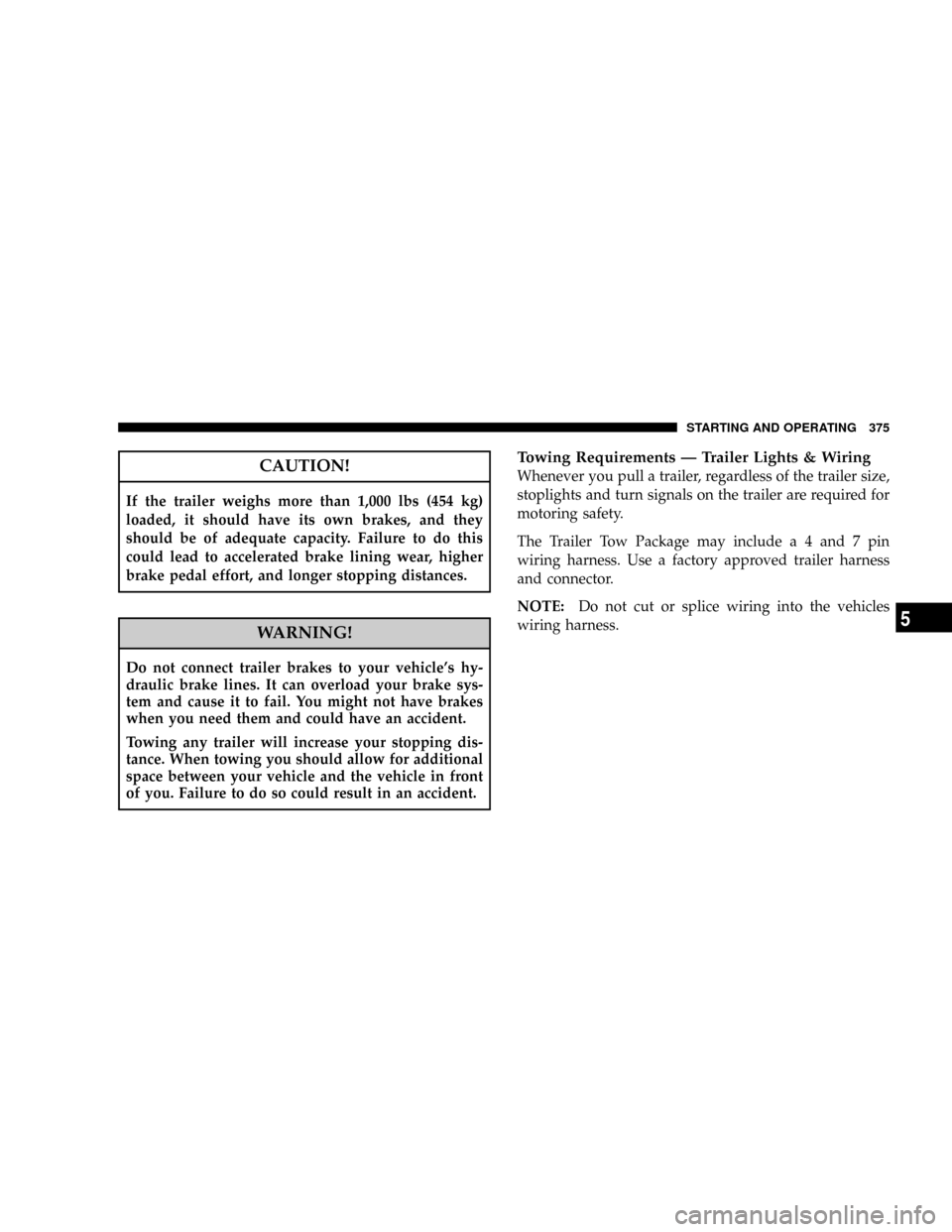Page 375 of 493

CAUTION!
If the trailer weighs more than 1,000 lbs (454 kg)
loaded, it should have its own brakes, and they
should be of adequate capacity. Failure to do this
could lead to accelerated brake lining wear, higher
brake pedal effort, and longer stopping distances.
WARNING!
Do not connect trailer brakes to your vehicle's hy-
draulic brake lines. It can overload your brake sys-
tem and cause it to fail. You might not have brakes
when you need them and could have an accident.
Towing any trailer will increase your stopping dis-
tance. When towing you should allow for additional
space between your vehicle and the vehicle in front
of you. Failure to do so could result in an accident.
Towing Requirements Ð Trailer Lights & Wiring
Whenever you pull a trailer, regardless of the trailer size,
stoplights and turn signals on the trailer are required for
motoring safety.
The Trailer Tow Package may includea4and7pin
wiring harness. Use a factory approved trailer harness
and connector.
NOTE:Do not cut or splice wiring into the vehicles
wiring harness.
STARTING AND OPERATING 375
5
Page 378 of 493

þUse speed control in flat terrain and with light loads to
maximize fuel efficiency.
Towing Tips Ð Cooling System
To reduce potential for engine and transmission over-
heating, take the following actions:
þCity Driving
When stopped for short periods of time, put transmission
in neutral and increase engine idle speed.
þHighway Driving
Reduce speed.
þAir Conditioning
Turn off temporarily.
þRefer to ªCooling Systemº under ªMaintenance Pro-
ceduresº in Section 7 of this manual for more informa-
tion.
RECREATIONAL TOWING (BEHIND
MOTORHOME, ETC.)
Towing ± 2WD Models
Recreational towing is not allowed.
CAUTION!
Towing with the rear wheels on the ground can result
in severe transmission damage.
Towing Ð 4WD Models
The transfer case must be shifted into Neutral (N) for
recreational towing. The Neutral (N) selection button is
located at the top of the 4WD Control Switch. Shifts into
and out of transfer case Neutral (N) can take place with
the selector switch in any mode position.
378 STARTING AND OPERATING
Page 380 of 493

3. Turn the ignition switch to the ON position.
4. Depress the brake pedal.
5. Shift the transmission to ªNº (Neutral) (automatic
transmission), or depress the clutch pedal (manual trans-
mission).
6. Use the point of a ballpoint pen or similar object to
depress the recessed transfer case Neutral (N) button for
4 seconds. After the shift is complete, and the Neutral (N)
light turns on, release the Neutral (N) button.
7. Start the engine.
8. Shift the automatic transmission into ªRº (Reverse).
9. Release the brake pedal for five seconds and ensure
that there is no vehicle movement.
10. Repeat Steps 8 and 9 with the transmission in ªDº
(Drive) (automatic transmission) or 1st gear (manual
transmission).11. Shut OFF the engine.
12. Turn the ignition switch to the unlocked OFF posi-
tion.
13. Shift the transmission into ªPº (Park) (automatic
transmission), or shift into 4th gear (manual transmis-
sion).
14. Attach the vehicle to a tow vehicle with a tow bar.
15. Disconnect the battery negative cable.
NOTE:
²Steps 1 through 5 are requirements for shifting the
transfer case. If these requirements are not met prior to
depressing the Neutral (N) selection button or while
the shift attempt is in process, then the Neutral (N)
indicator light will flash continuously until all require-
ments are met or until the Neutral (N) button is
released.
380 STARTING AND OPERATING
Page 381 of 493

²The ignition switch must be in the ON position for a
shift to take place and for the position indicator lights
to be operable. If the ignition switch is not in the ON
position, the shift will not take place and no position
indicator lights will be on or flashing.
²Flashing Neutral (N) position indicator light indicates
that shift requirements have not been met.
CAUTION!
Damage to the transmission may occur if the trans-
mission is shifted into ªPº (Park) with the transfer
case in Neutral (N) and the engine RUNNING. With
the transfer case in Neutral (N), ensure that the
engine is OFF prior to shifting the transmission into
ªPº (Park).
Shifting Out of Neutral (N)
Perform the following procedure to prepare your vehicle
for normal usage:
1. Bring the vehicle to a complete stop.
2. Reconnect the battery negative cable.
3. Place the ignition switch in the LOCK position (if it
has been moved or the engine has been started).
4. Turn the ignition switch to the ON position, but do not
start the engine.
5. Depress the brake pedal.
6. Shift the transmission into ªNº (Neutral) (automatic
transmission), or depress the clutch pedal (manual trans-
mission).
7. Use the point of a ballpoint pen or similar object to
depress the recessed transfer case Neutral (N) button.
Release the Neutral (N) button after the Neutral (N)
STARTING AND OPERATING 381
5
Page 382 of 493

indicator light turns off (approximately 1 second). After
the Neutral (N) button is released, the transfer case will
shift to the position identified by the selector switch.
8. Start the engine.
9. Shift the transmission into ªDº (Drive) (automatic
transmission) or into 1st gear and momentarily release
the clutch (manual transmission) to verify that the trans-
fer case has engaged.
10. Set the parking brake.
11. Shift the transmission into ªPº (Park) (automatic
transmission), or into ªNº (Neutral) (manual transmis-
sion).NOTE:
²Steps 1 through 6 are requirements for shifting the
transfer case. If these requirements not met prior to
depressing the Neutral (N) selection button or while
the shift attempt is in process, then all of the mode
position indicator lights will flash continuously until
all requirements are met or until the Neutral (N)
button is released.
²The ignition switch must be in the ON position for a
shift to take place and for the position indicator lights
to be operable. If the ignition switch in not in the ON
position, the shift will not take place and no position
indicator lights will be on or flashing.
²Flashing Neutral (N) position indicator light indicates
that shift requirements have not been met.
382 STARTING AND OPERATING
Page 389 of 493
5. Raise the vehicle by turning the jack screw to the right.
Raise the vehicle only until the tire just clears the surface
and enough clearance is obtained to install the spare tire.
Minimum tire lift provides maximum stability.
WARNING!
Raising the vehicle higher than necessary can make
the vehicle less stable and cause an accident. It could
slip off the jack and hurt someone near it. Raise the
vehicle only enough to remove the tire.
6. Remove the lug nuts and wheel.
7. Position the spare wheel/tire on the vehicle and install
lug nuts with cone-shaped end toward wheel. Lightly
tighten the nuts. To avoid the risk of forcing the vehicle
off the jack, do not tighten the nuts fully until the vehicle
has been lowered.
8. Lower the vehicle by turning the jack screw to the left,
and remove the jack and wheel blocks.
9. Finish tightening the lug nuts. Push down on the
wrench while tightening for increased leverage. Alternate
Rear Jacking Location
WHAT TO DO IN EMERGENCIES 389
6
Page 397 of 493
mReplacement Light Bulbs.................443
mBulb Replacement......................443
NHeadlight...........................443
NFront Turn Signal And Front Side Marker
Lights.............................444
NFront Fog Light......................445NRear Tail/Stop, Turn Signal, And Back-Up
Lights.............................445
mFluid Capacities........................447
mFluids, Lubricants, And Genuine Parts........448
NEngine.............................448
NChassis............................449
MAINTAINING YOUR VEHICLE 397
7
Page 399 of 493

ONBOARD DIAGNOSTIC SYSTEM Ð OBD II
Your vehicle is equipped with a sophisticated onboard
diagnostic system called OBD II. This system monitors
the performance of the emissions, engine, and automatic
transmission control systems. When these systems are
operating properly, your vehicle will provide excellent
performance and fuel economy, as well as engine emis-
sions well within current government regulations.
If any of these systems require service, the OBD II system
will turn on the ªMalfunction Indicator Light.º It will
also store diagnostic codes and other information to
assist your service technician in making repairs. Al-
though your vehicle will usually be drivable and not
need towing, see your dealer for service as soon as
possible.CAUTION!
²Prolonged driving with the ªMalfunction Indica-
tor Lightº on could cause further damage to the
emission control system. It could also affect fuel
economy and driveability. The vehicle must be
serviced before any emissions tests can be per-
formed.
²If the ªMalfunction Indicator Lightº is flashing
while the engine is running, severe catalytic con-
verter damage and power loss will soon occur.
Immediate service is required.
MAINTAINING YOUR VEHICLE 399
7